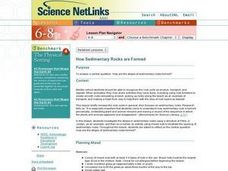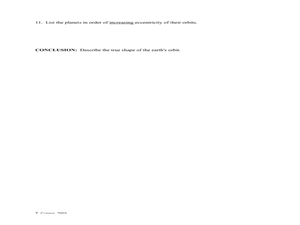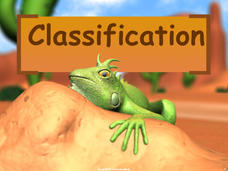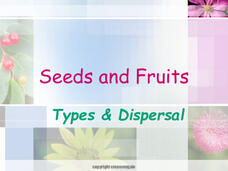Science 4 Inquiry
All the Small Things
Scholars use sorting cards to try to define a pure substance versus a mixture. Risk becomes reward as they observe the differences and create a flowchart sorting matter into mixtures and pure substances (elements and compounds).
Howard Hughes Medical Institute
Lactose Intolerance: Fact or Fiction
Around the world, about 2/3 of adult humans are lactose intolerant. Scholars work in small groups to discuss a few statements about lactose intolerance. Then, they watch a video on the topic and readdress each statement. Whole-class...
Curated OER
How Sedimentary Rocks are Formed
Students investigate the stripes in sedimentary rocks, using a structure at Petra, Jordan, as an example, and then do a hands-on activity using mixed nuts to illustrate the layering of sedimentary rocks.
Curated OER
The Wingra Marsh: A Purple Population Problem
Students engage students in an ecological inquiry. They author a presentation to the Grounds Management Committee of their school giving their recommendation for the control of the invasive species purple loosestrife (Lythrum salicaria)...
Curated OER
Let's Get it Together! Reading to Learn
Let’s learn about frogs! Young readers are led through “Freaky Frogs,” a non-fiction article. Teach learners how to edit an article so there are fewer details to sift through. After talking through the article, they learn the six steps...
Curated OER
Can Young Children Distinguish Between Living and Non-living Things?
What does it mean to be living? Help your young scientists identify living and non-living things as a result of their learning through discovery. Observation of and interaction with a set of natural phenomena in their community will make...
Biology Junction
Cell Structure and Function Crossword
For this biology worksheet, learners complete a crossword puzzle with 46 questions on cell structure and function. They identify different cell organelles.
Curated OER
Ellipse Lab
Leading the students to draw a representation of ellipses of planets, this handout will help understanding the planet movement around the sun. There are ten questions about the analysis of those orbits and a conclusino specifically...
Exploratorium
Water Sphere Lens
With a Florence flask or fishbowl, make a double convex lens and use it to examine an image. Because of the refraction, the image will be inverted. A simple explanation is provided here for you to share with your class as they...
Anglophone School District
Fluids: Force in Fluids
Discuss Archimedes' Principle and fluid forces with your young scientists as they describe the relationship between mass, volume, and density during a series of engaging activities. They use the Participle Theory of Matter to explore the...
NOAA
Biological Oceanographic Investigations – Through Robot Eyes
How can a robot measure the length of something when we don't know how far the camera is from the object? The lesson explains the concept of perspective and many others. Scholars apply this knowledge to judge the length of fish and the...
Columbus City Schools
Sedimentary Rocks
Turn your class discussion of rock formation from ho-hum to holy hornfels! Junior geologists gain experience in identifying rock types and rock origins, with an emphasis in hypothesizing the environment needed to form certain rocks. The...
Science 4 Inquiry
The Classification of Living Things
It's a classification sensation! Demystify why we classify using an inquiry activity that helps your class sort things out. Groups begin by classifying a variety of shoes before they research organisms and design their own dichotomous...
Science 4 Inquiry
The Real Story of Where Babies Come From
Pupils learn about both male and female anatomy before understanding how they work together to make a baby. Scholars discover new vocabulary, create a presentation on fertilization, and discuss related topics.
Howard Hughes Medical Institute
Stalking the Genetic Basis of a Trait
Need an a-maize-ing lesson to show your class how regulatory genes work? If you use the well-written resource, they'll be all ears! Biology scholars discover the gene responsible for the evolution of the modern-day corn plant through a...
Biology Junction
Lab Safety
Do scholars know what to do if a friend suffers an electrical shock? The presentation opens with lab safety and expectations. It includes general safety tips as well as reminders for glassware, chemical, electrical, and heating safety....
Biology Junction
Invertebrates
How many different invertebrates can you name? A thorough presentation describes the eight different Phyla of invertebrates. Each slide gives a quick overview of the important physical characteristics of each of the Phyla.
Biology Junction
Arthropods
Even the creepy crawlers have pretty amazing anatomy! A thorough lesson describes characteristics of arthropods with an emphasis on their structures. Beginning with a review of the taxonomy hierarchy, the lesson explains the different...
Biology Junction
Echinoderms
Turn a walk on the beach into an in-depth biology lesson! Scholars learn about the different classes of echinoderms in an informative PowerPoint presentation. The lesson explains the unique characteristics of the five different classes...
Biology Junction
DNA and Replication
Enzymes proofread DNA, reducing the error rate to one in one billion base pairs. Learn about the important process and so much more with the help of a presentation. It opens with the history of DNA and the major scientific contributions...
Biology Junction
Classification of Life
Did you know scientists identify more than 13 billion species of organisms, and they discover more almost every day? An interesting presentation demonstrates how scientists keep track of so many species. It also shows how they...
Biology Junction
Seeds and Fruits: Types and Dispersal
Did you know that some seeds rely on elephant dung for dispersal? Pupils use class discussion and direct instruction based around a presentation to learn about seed types and dispersal methods. Slides vary from presenting content to...
Curated OER
Reptiles and Amphibians
Introduce your class to various reptiles and amphibians. They will meet and identify a representative from each of the four major reptile families, then learn about and discuss reptile characteristics. Next, they will identify and...
Chicago Botanic Garden
Climate Change Around the World
Look at climate change around the world using graphical representations and a hands-on learning simulation specified to particular cities around the world. Using an interactive website, young scientists follow the provided directions to...

























